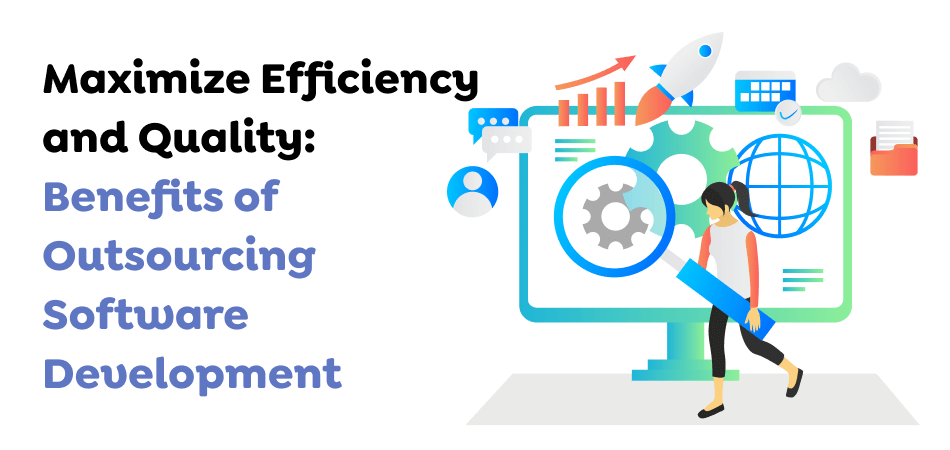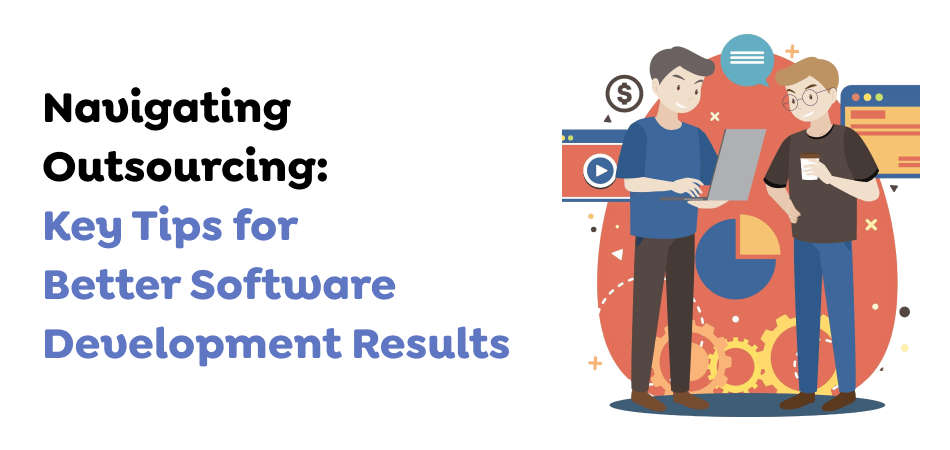26 Dec 2024
Why Outsourcing Software Development is the Key to Business Growth
Matthew Connor

Outsourcing software development has been a go-to strategy for companies seeking to lower expenses, access specialized skills, and mitigate risks. In recent years, Canada has emerged as an increasingly popular destination for US businesses to hire a software development company, a shift from the trends of the past.
This article highlights why outsourcing software development from Canada can offer significant advantages for US-based organizations. For those still evaluating whether outsourcing aligns with their goals, the blog here will provide a thorough understanding of the benefits and different models. Before we delve deeper, it’s essential to establish a clear definition of the core terms.
Understanding Outsourcing, Offshoring, and Nearshoring

Let’s break down the key terms to better understand the distinctions between outsourcing, offshoring, and nearshoring:
What is Outsourcing?
Outsourcing is a broad concept that involves delegating certain tasks or operations from your organization to an external third party. This could make the external provider even a neighbor, a state away, or a different country or continent. In IT services, software development, customer support, and countless other areas, outsourcing relieves the focal organization of noncore tasks while allowing the company to benefit from expertise and lower costs.
What is Offshoring?
Offshoring can be defined as outsourcing an individual business process or service to a different geographical location or even a different continent. While outsourcing means contracting out some business activities, offshoring is a subset of outsourcing that entails transferring an organization’s activities to another country. For example, if a firm in Canada subcontracts software development services from the US, then it is offshoring.
What is Nearshoring?
Nearshoring takes outsourcing closer to home by partnering with service providers in a neighboring country or region. Such an approach helps keep near or closer, often helping the companies reap the benefits of operating within the same time zones, culture, or language. For example, a company in Canada that outsourced its software development to the US is a nearshoring example. This option has benefits derived from outsourcing but is coupled with geographical and cultural proximity.
By understanding these terms, businesses can better evaluate which approach aligns with their goals, whether it’s leveraging local talent, minimizing costs, or maintaining seamless collaboration.
Now, let’s explore the top 10 advantages of outsourcing software development.
Also Read : The Ultimate Guide To EHR Software Development: Enhancing Healthcare Efficiency
Top 10 Advantages of Outsourcing Software Development

Outsourcing software development to Canada is increasingly gaining popularity. Let’s explore the key reasons driving this trend:
1. Affordable Solutions Without Compromising Quality:
Canada offers competitive pricing for software development services, striking the perfect balance between affordability and high standards. The strong US dollar provides significant exchange rate benefits, making Canadian outsourcing particularly cost-efficient for US businesses. This saves you a lot of money and, coupled with the exceptionally high quality evident in software products, means investing in our services is a sound decision.
2. Close Proximity and Time Zone Alignment:
Canada’s geographical proximity to the US is a significant advantage. Large cities are near the American border, where time differences are generally small. The closeness of these offices enables easy and fast communication, as people are next to each other. Physical meetings can also be arranged easily, as people are in close contact. This can eliminate the problems often encountered, especially when outsourcing to other regions.
3. Seamless Business Operations:
Over time, Canadian laws and business environments have grown to mirror the United States. This makes contractual relations easier regarding negotiations and other operations, hence enforcing easier business relations. All such synergy will create trust and would reduce risks since making outsourcing experiences a hassle-free option.
4. Exceptional Quality Standards:
Canada has proved itself to be the advanced and leading producer of qualitative software. Due to their skilled tech workforce and advanced technologies, Canadian developers are continually responsive to the latest technologies, such as AI and machine learning.
5. Highly Skilled Workforce:
The developers in Canada are some of the most educated and skilled across the entire world. Canada currently has one of the strongest developer pools of any country with 66% of Canadians with an adequate age and educational level having tertiary education degrees. Cities such as Toronto, Vancouver, and Montreal contain highly skilled professionals using up-to-date tools to develop software supported by globally employed methods.
6. Shared Cultural Values and Work Ethics:
Similar to the American culture, Canadian counterparts understand each other well and, therefore, are in a better position to cooperate. Communication compatibility, standardized celebrations, and working cultures contribute to the overall coordination and goal achievement in an organization.
7. Supportive Trade Agreements:
Trade agreements like the USMCA (United States-Mexico-Canada Agreement) simplify cross-border transactions, safeguard intellectual property, and ensure fair labor practices. These agreements bring reliability and stability to this field of business and make Canada suitable for outsourcing partnerships with US firms.
8. Economic and Political Stability:
Canada has a stable environment with regard to political and economic stability, which makes it safe to outsource. Ranked as the most fiscally sound country in the G20, Canada offers a reliable foundation for long-term outsourcing partnerships.
9. Flexibility to Scale Operations:
Outsourcing to Canada tends to be more advantageous to companies, as they can easily expand or decrease their need for software developers. Canadian firms are flexible enough to meet any short-term needs or larger goals, helping clients get a smooth outsourcing solution.
10. Accelerated Time-to-Market:
The nearshore model also suits Canada because there are no time zone differences, no language barriers, and no issues with working hours. It assists companies in continuing to sustain market competitiveness while letting their organizational units attend to other important matters.
Moving forward, now let’s discuss the step-by-step process of outsourcing software development.
Also Read : Why Custom ERP Software Development is a Smart Investment for Growing Businesses
Understanding the Process of Outsourcing Software Development

Software outsourcing is a complex task that must be approached with much thought and strategy to succeed. By choosing the right development partner and or following a structure, you are sure to overcome these problems in order to meet the project objectives. While the exact process may vary depending on the industry and specific needs, here is a streamlined guide to how outsourcing software development typically works:
Step 1: Define Your Project Objectives
The first step is to properly identify your work’s objectives and sphere. This includes identifying what you aim to develop, the budget available, the timeline for completion, and the outcomes you expect to achieve. A comprehensive understanding of your project is essential to determine the best outsourcing model and set a solid foundation for the process.
Key considerations at this stage include:
- Outlining project requirements and deliverables.
- Setting a realistic budget.
- Establishing clear timelines and milestones.
- Identifying specific technical and functional needs.
Step 2: Research and Select the Right Partner
Now that you have all your project details, you must identify a proper outsourcing software development partner to deliver your project. This can be a herculean task, yet it involves a great deal of searching for the company that will be most appropriate in the industry with the requisite expertise and experience and the favorable results of what the company has undertaken.
Important steps during this phase include:
- Shortlisting potential partners based on their portfolios, reviews, and references.
- Evaluating their technical capabilities, methodologies, and communication processes.
- Understanding their engagement models and pricing structures.
- Assessing their compatibility with your organizational culture and goals.
Step 3: Kickstart the Project
When you have identified the right outsourcing partner, the project is initiated with a detailed initial meeting. This is where you create a development plan and where you review and set your expectations concerning your internal staff and the outsourcing company.
Key activities during the project initiation phase include:
- Defining roles and responsibilities.
- Establishing communication protocols and tools.
- Setting up reporting and feedback mechanisms.
- Outlining the project’s workflow and deliverable timelines.
Step 4: Execute the Development Process
With a strategic plan in place, the software development team begins the actual engineering process. Depending on your chosen outsourcing model, this phase may involve:
- Staff Augmentation Model: This model is perfect for organizations that seek to augment their in-house workforce. An outsourced team may be collocated with their in-house employees and is responsible for one or more stages of development. It also allows your in-house team to be closely acquainted with the project while simultaneously unleashing the outsourcing advantage, whereby your project has an advantage over other programmers/developers without relinquishing control over outsiders.
- Dedicated Team Model: The dedicated team model provides better control to the outsourced team as they manage the whole project. In this environment, the external development team is involved in planning and controlling the tasks and supervising the project. It is preferred when the company needs first-class software developers to work on specific, mostly unsupervised, segments of the project.
- Project-Based Model: Project-based outsourcing has the characteristics in which the outsourcing company undertakes full responsibility for the development process. This ranges from creating project objectives and defining the goals and features of work to scheduling work, managing time, and even ensuring quality. This model is best suited for an organization that wants to outsource the whole job to a third-party provider while not Depending on the provider directly each day.
Throughout the development phase, continuous collaboration, progress monitoring, and iterative feedback ensure that the project aligns with your vision and goals.
Step 5: Final Delivery and Post-Launch Support
The last phase is to implement the software solution after it has gone through the expected timeline and quality standards. However, outsourcing is not limited to delivery; it is followed by continuous support and maintenance for it to succeed.
Key considerations post-delivery include:
- Conducting thorough testing to ensure optimal performance and functionality.
- Providing updates and implementing enhancements as needed.
- Offering technical support and resolving any issues that arise.
- Planning for future upgrades or scaling based on business needs.
After learning the step-by-step process, let’s now discover the key considerations that can ensure a seamless and successful outsourcing experience.
Also Read : Transforming Operations: The Role of Oil and Gas Software Development
Key Considerations When Outsourcing Software Development

1. Selecting the Right Development Partner:
A strong partnership begins with mutual understanding and alignment on project goals. Always clearly define the parameters of what you will be doing, creating, and when. Look into what type of company you are outsourcing to, check their portfolio, and assess their recruitment process and technical skills to determine if you and their needs match.
2. Choose the Outsourcing Model That Suits Your Needs:
It enables someone to fully understand the many outsourcing strategies so as to select the most appropriate strategy for your firm. Regardless of whether you locate yourself in a requirement for searching out an offering of a dedicated team, project-based offering model, or staff augmentation offering model, you need to look at your strengths and weaknesses inside your organization before you decide which is the one that you would like to take for a project.
3. Establish Clear Expectations from the Start:
Rules are the precursors of success because they create a clear expectation of what should be done or expected. You should clearly state what you want to accomplish in the project, when, and what is expected of you. In particular, meetings involving assessment and feedback throughout the project life cycle will enable the team to check the project’s progress and identify any deviations to avoid costly problems.
4. Prioritize Effective Communication:
Clarity is a requirement for orderly interaction and is fundamentally important when it comes to outsourced stakeholders. The desired communication should also be determined to avoid misconceptions that may be dangerous to the overall results of the project.
5. Plan for Scalability:
Software development is an ongoing process, and scalability is very important for future business. Choose an organization that addresses scalability as part of the development strategy in order to design your software for growth. A good maintenance plan will mitigate the challenges as they present themselves so that the software runs optimally in the future.
This approach focuses on delivering high-quality, people-first content that provides valuable, comprehensive information while avoiding over-optimization. The content should serve the reader’s needs while maintaining technical accuracy and expertise.
Now, let’s discover why Techugo stands out as the best choice for outsourcing software development, offering unparalleled expertise, innovation, and tailored solutions.
Also Read : The Complete Guide to POS Software Development: Types and Benefits
Why Techugo is the Best Choice for Outsourcing Software Development

Techugo, a leading software development company in Canada, is an ideal partner for outsourcing due to its proven expertise and skilled talent pool. Our company offers a wide range of services across industries, ensuring high-quality, innovative solutions tailored to your needs. With a team of experienced developers and engineers, Techugo leverages the latest technologies to deliver robust software that meets complex requirements.
In addition to its technical capabilities, Techugo offers cost-effective solutions by utilizing the favorable exchange rate between the US and Canada, making it a budget-friendly choice without compromising quality. The company’s geographical proximity to the US and shared cultural values ensure seamless communication and collaboration, resulting in faster project turnaround times.
In A Nutshell!
In conclusion, outsourcing software development to Canada offers numerous advantages for US-based businesses, including cost-efficiency, skilled talent, and strong cultural and geographical alignment. The close proximity, shared language, and time zone similarities between the US and Canada foster smoother collaboration and reduce delays. Additionally, Canada’s stable political and economic environment, coupled with strong trade agreements, makes it a reliable and secure outsourcing destination. By leveraging these benefits, US businesses can maintain competitive advantage, enhance operational flexibility, and tap into a world-class talent pool, ensuring successful software development projects.
Choosing the right outsourcing partner and model is critical to maximizing the potential of this strategy. By carefully evaluating your project’s scope and requirements and establishing clear expectations from the outset, businesses can ensure seamless communication and effective collaboration with their outsourced teams. Ultimately, outsourcing software development to Canada enables businesses to focus on their core operations while accessing high-quality, scalable solutions that drive innovation and business growth.
Ready to take your project to the next level? Get in touch with us for expert outsourcing software development services and unlock your business potential!
Get In touch
We are excited to here from you and let’s start something special Together. Call Us for any inquiry.
Write us
sales@techugo.caJust a call away
About you




